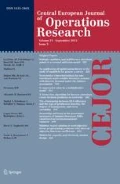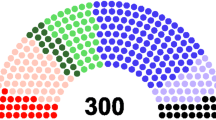Abstract
According to yes–no voting systems, players (e.g., parties in a parliament) have some influence on making some decisions. In formal voting situations, taking into account that a majority vote is needed for making a decision, the question of political power of parties can be considered. There are some well-known indices of political power e.g., the Shapley–Shubik index, the Banzhaf index, the Johnston index, the Deegan–Packel index. In order to take into account different political nature of the parties, as the main factor for forming a winning coalition i.e., a parliamentary majority, we give a modification of the power indices. For the purpose of comparison of these indices of political power from the empirical point of view, we consider the indices of power in some cases, i.e., in relation to a few parliaments.





Similar content being viewed by others
References
Cortona PG, Manzi C, Pennisi A, Ricca F, Simeone B (1999) Evaluation and optimization of electoral systems. SIAM, Philadelphia
Leech D (2002) Computation of power indices. Department of Economics, University of Warwick, Coventry
Leech D, Leech R (2016) Computer algorithms for voting power analysis. http://homepages.warwick.ac.uk/~ecaae/. Accessed Sept 2016
Marošević T, Sabo K, Taler P (2013) A mathematical model for uniform distribution of voters per constituencies. CRORR 4:53–64
Matsui T, Matsui Y (2000) A survey of algorithms for calculating power indices of weighted majority games. J Oper Res Soc Jpn 43:71–86
Mielcová E (2016) Spatial power indices with applications on real voting data from the Chamber of Deputies of the Czech Parliament. CEJOR 24:407420. doi:10.1007/s10100-015-0406-7
Nancy J (2015) European parliamentary research service, review of European and national election results. http://www.europarl.europa.eu/pdf/meps/EP_-Review_-update_-3_-en.pdf. Accessed Sept 2016
Pajala A, Meskanen T, Kause T (2002) Powerslave power index calculator: a voting body analyser in the voting power and power index website. Updated 31.5.2007. University of Turku. http://powerslave.val.utu.fi/. Accessed Mar 2017
Taylor AD (1995) Mathematics and politics. Springer, Berlin
Author information
Authors and Affiliations
Corresponding author
Additional information
The second author was supported by the Croatian Science Foundation under the Project No. 6422.
Rights and permissions
About this article
Cite this article
Marošević, T., Soldo, I. Modified indices of political power: a case study of a few parliaments. Cent Eur J Oper Res 26, 645–657 (2018). https://doi.org/10.1007/s10100-017-0487-6
Published:
Issue Date:
DOI: https://doi.org/10.1007/s10100-017-0487-6




